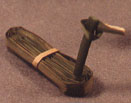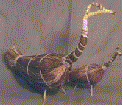| FIGURES & ORNAMENTS
| ID#
| DESCRIPTION
| PRICE
|
| Native American Style Figures
|
 |
Fi1
| Cattail Duck Decoy
Floating duck decoys like these (measuring about 14 ") long are an essential hunting tool to lure birds to within reach of the bow and arrow, spear, or net. Duck decoys were constructed from reeds by Native Americans that lived during the Archaic period (2,000 years ago) west of the Colorado Plateau. Archaeologists working in Nevada found nearly a dozen ancient duck decoys cached in Lovelock Cave, a large cave that opens up onto fossil Lake Lahontan. Decoys from Lovelock Cave were made from tule reed, a plant species related to bulrush. There are many varieties of bulrush, a round hollow, tall reed which grows around wetlands across North America. Unfortunately, some more resilient European introduced plants like purple loosestrife and aggressively invasive phragmities reeds have squeezed out many colonies of indigenous plants like bulrush.
| Not Available at this time.
|
 |
Fi2
| Miniature Cattail Duck Decoy
A single cattail leaf can also be wrapped around to form tiny ducks, which because of the buoyancy of cattail, can float endlessly in water. Like split-willow figures of Western Tribes, the small (2.5 inch) ducks may have traditionally been made for hunting rituals. Historically, Ojibwa made the tiny ducks for their children, often made in flocks of five and placed in a pond or puddle. Blow gently on the water and the rocking ducks look like a life-like flock.
| Not Available at this time.
|
 |
Fi3
| Red Willow Stick Deer
On the Colorado Plateau of Utah, in Cowboy Cave, archaeologists have found many split willow figures representing deer, some that were made by Native Americans 3,500 years ago. Often these ancient split willow deer (3 inches long) are found in ceremonial contexts, but in this cave they were found battered and broken among ordinary refuse in layers of fill, suggesting that the deer had a more secular use, perhaps as children's toys. Some of these deer more aptly resemble a llama, having a tall body and short legs. In making the willow deer, only a single unbroken split willow is needed. A long branch is split down its length, leaving the last few inches of the wide end unsplit. The unsplit end of the branch forms the rear leg, and the two halves of the split branch are used to wrap the body and form the head.
| Not Available at this time.
|

| Fi4
| Sweetflag Goose Decoy (7-8 inches tall)
| Not Available at this time.
|
Fi5
| Miniature Sweetflag Goose Decoy (2-3 inches tall)
| Not Available at this time.
|
 |
Fi6
| Cradleboard Ornament - Wooden Hoop Woven with Cattail Leaf
Frances Densmore conducted an extensive study of material culture of the Ojibwe/Chippewa living in Minnesota, Wisconsin and Ontario, Canada in the early 1900’s. She described that traditionally articles representing spider webs were hung from the hoop of a child’s cradle board, and it was said that ‘they catch and hold everything evil as a spider’s web catches and holds everything that comes into contact with it’. It is interesting to note that the weave of this traditional charm is different from dream catchers seen today. This unique 3" dream catcher is a reproduction of a cradleboard charm in the Minnesota Historical Society collections.
| Not Available at this time.
|


